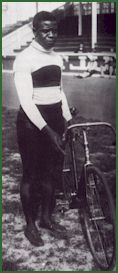 |
|
League rights a wrong, TELEGRAM & GAZETTE
It was in Louisville in 1894 that the League of American Wheelmen, then the governing body of bicycle racing, voted to ban blacks. The color line, and subsequent maneuvering over the governance of the sport, had a particular effect on the career of an up-and-coming rider from Indianapolis named Marshall W. "Major" Taylor. Racial segregation relegated young Taylor to blacks-only racing clubs. By the end of 1896, a year after moving with his coach and employer to Worcester, 18-year-old Taylor was the undisputed black champion of America. But he aimed to be the fastest bicycle rider in the world, period. In the Northeast, where the color line had been opposed, Taylor encountered more open-mindedness, and the league allowed him to enter the pro ranks. Still, racial intolerance was an obstacle on and off the race track. Because he was black, Taylor was refused entry to key races in the South and was sometimes denied lodging while on the road. White riders conspired against him, and the hostility sometimes turned violent. One opponent hauled him off his bike and choked him into unconsciousness. When Taylor bought a house in well-to-do Columbus Park in Worcester, the white neighbors were alarmed and tried to buy it back. Nonetheless, Taylor kept his eyes on the prize, and his perseverance paid off. At the end of 1898, the 20-year-old "Worcester Whirlwind" held seven world records. In 1899 in Montreal, he won the world championship in the one-mile sprint. He was the second black world champion in any sport, after bantamweight boxer George Dixon. Next weekend, the League of American Bicyclists -- a successor to the 19th-century league, though it is now an advocacy group and does not govern racing -- convenes in Louisville for its national rally and annual meeting. League president Earl Jones, an African-American who lives in Louisville, is asking the league's board of directors, in remembrance of Major Taylor, to formally repeal the color line established in 1894. The league has no records indicating the ban on black members was ever officially revoked, according to Jones' proposed resolution, which will be put to a vote Saturday. The heart of the resolution reads: "The board of directors hereby disavows the action of the 1894 League of American Wheelmen convention, repeals the 1894 resolution and reaffirms our commitment to diversity of membership." Jones always wondered why he saw so few African-Americans in bike clubs and bike races, especially after Taylor had reached such prominence in the 1890s. When he learned of Louisville's role in the league's history, he took it to heart. "It was clear that this was the time and place to make amends for that historic wrong," Jones said. "And what better way to do it than to pay tribute to one of its victims, a man who exemplified the continuing struggle of all cyclists to be the best they can be at their sport. "Finally, I hope that the League, by taking this step, can lead cycling into more diverse and representative participation." Sports historian Andrew Ritchie, author of the biography "Major Taylor," will be the featured speaker at the Louisville gathering. Junior national track cycling champion Giddeon Massie, 17, of Lansdale, Pa., a black rider inspired by Taylor, will be honored. Locally, the Major Taylor Association is planning a centennial tribute to the 1899 champ July 23 at Quinsigamond State Park in Worcester. More on that in July. Full text of the LAB resolution Major Taylor | Statue | Events | Donations | News | Friends | Home Major Taylor Association, Inc. P.O. Box 20131 Worcester, MA 01602 info@majortaylorassociation.org ©2000 - 2002 Major Taylor Association, Inc. All rights reserved. Web design by Tom Swenson. |
